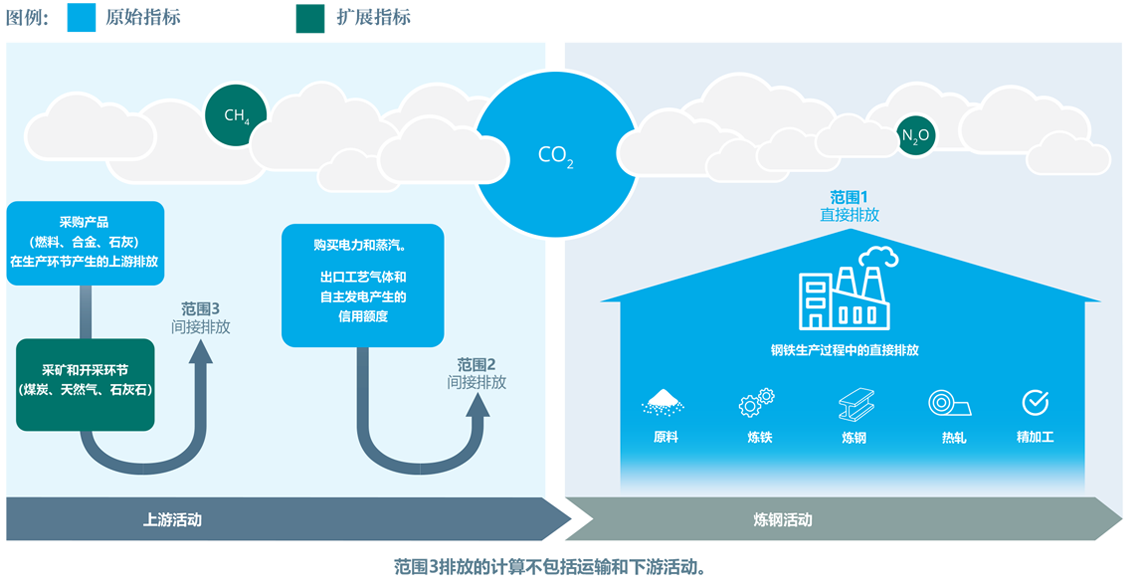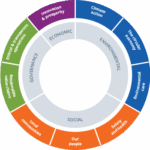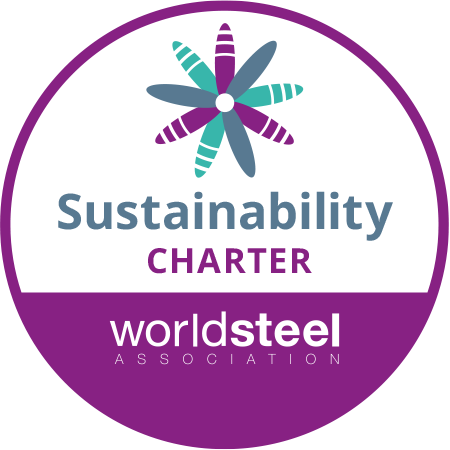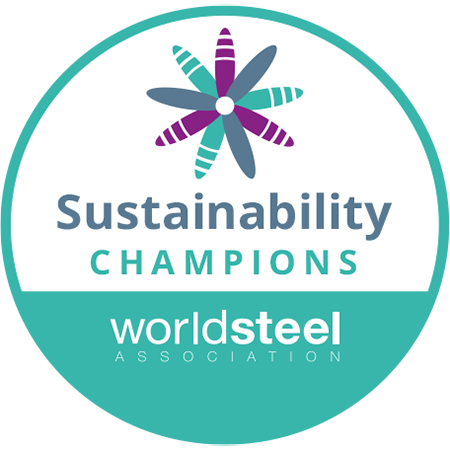引言
随着气候变化、生物多样性丧失、环境污染以及人们对更具包容性和韧性经济的需求的日益增长,世界面临的挑战也在不断升级。因此可持续发展不仅仅是一个愿景,已经发展成为塑造我们生活、工作和未来建设的必然要求。
作为现代社会发展的基石,钢铁行业深知其在推动可持续发展进程中肩负的重要使命。从连接社群的基础设施建设,到推动低碳经济发展的创新成果,钢铁始终是转型发展的核心支柱,钢铁行业肩负着引领变革的重要责任。
在联合国可持续发展目标和《巴黎协定》等全球框架的指引下,这份《可持续发展指标报告2025年版》再次重申了钢铁行业长期以来对透明度、问责制和持续改进的坚定承诺。报告展示了钢铁行业如何在关键议题领域持续开展衡量、管理和提升工作,彰显了我们满足社会不断变化的期望,为可持续发展的未来做出有意义的贡献。
我们将继续携手共同开辟一条通往更可持续、更具韧性且更包容的钢铁行业之路,它不仅能满足当下的需求,更能守护未来的无限可能。

2025年主要可持续发展项目
可持续发展指标
鉴于可持续发展挑战的相互关联性,钢铁行业将监测框架从8项指标扩展到19项,为环境、社会和治理绩效提供了更全面的视角。这一演变强化了我们的共同动力,即更全面地认识我们行业的影响,并将这种认识转化为可测量的、持久性的进步。
粗体显示的指标为2024年新增指标。

更多关于可持续发展原则,请访问世界钢铁协会网站:worldsteel.org。
可持续发展指标
粗体显示的指标为2024年新增指标。
| 指标 | 单位 | 2022 | 2023 | 2024 | |
| 环境绩效 | |||||
| 1a | 温室气体排放强度 | 吨二氧化碳当量/吨粗钢 | 2.18 | ||
| 1b | 二氧化碳排放强度 | 吨二氧化碳排放量/吨粗钢 | 1.92 | 1.92 | 1.92 |
| 2 | 能耗强度 | 吉焦/吨粗钢 | 21.01 | 21.30 | 20.95 |
| 3 | 材料效率 | 总产出材料转化为产品和共生产品(副产品)的比例(%) | 97.60 | 93.14 | 92.79 |
| 4 | 环境管理体系 | 在通过环境管理体系认证的生产设施中工作的员工和协力工比例(%) | 97.19 | 90.82 | 96.08 |
| 5 | 可再生能源消耗 | 占总能耗的比例(%) | 1.94 | ||
| 6 | 硫氧化物排放强度 | 千克硫氧化物/吨粗钢 | 0.67 | ||
| 7 | 氮氧化物排放强度 | 千克氮氧化物/吨粗钢 | 0.71 | ||
| 8 | 粉尘排放强度 | 千克颗粒物/吨粗钢 | 0.41 | ||
| 9 | 水资源提取 | 立方米/吨粗钢 | 8.50 | ||
| 10 | 水资源使用 | 立方米/吨粗钢 | 2.30 | ||
| 社会绩效 | |||||
| 11 | 误工工伤率 | 工伤数/百万工时 | 0.85 | 0.76 | 0.72 |
| 12 | 员工培训 | 培训天数/员工 | 8.22 | 8.98 | 6.77 |
| 13 | 女性员工 | 占员工总数比例(%) | 11.44 | ||
| 14 | 董事会女性董事成员 | 占董事会成员总数比例(%) | 14.06 | ||
| 15 | 社区投资 | 占营业收入比例(%) | 0.08 | ||
| 经济绩效 | |||||
| 16 | 新工艺和新产品投资 | 占营业收入比例(%) | 6.37 | 7.27 | 8.31 |
| 17 | 分配的经济价值 | 占营业收入比例(%) | 96.57 | 98.83 | 100.68 |
| 治理绩效 | |||||
| 18 | 供应商行为准则评估 | 占活跃的原料供应商总数的比例(%) | 79.72 | ||
| 19 | 员工商业准则或道德教育 | 占员工总数比例(%) | 88.07 | ||
二氧化碳和温室气体排放强度
世界钢铁协会更新二氧化碳排放报告—扩大报告范围,涵盖温室气体排放报告
报告首次将行业层面及生产工艺路线层面的排放强度指标进行了扩展,在现有二氧化碳的基础上,包含甲烷和一氧化二氮,同时纳入上游采矿环节产生的排放。我们亦在更新排放因子。
实施这些调整,旨在使我们的报告更符合温室气体核算体系、ISO标准、世界钢铁协会自身的生命周期评价框架以及科学碳目标倡议指南中提出的要求。这些调整标志着我们在透明度和公信力方面向前迈出了重要一步。
对报告数据的影响
调整后的结果导致每吨钢报告的排放量数值更高。这并不代表实际排放量的增加,而是反映了核算方法的改进和覆盖范围的扩大。重要的是,这些调整因素在整个时间序列上的应用并不会改变钢铁行业的长期发展轨迹。我们的历史绩效趋势仍然保持不变。
更多关于调整后的计算内容,请参阅世界钢铁协会网站 worldsteel.org 上发布的《气候变化与钢铁生产》政策文件。
2024年温室气体排放强度
| 高炉 – 转炉流程 | 以废钢为原料的电炉流程 | 以直接还原铁为原料的电炉流程 | 全球 | |
| (废钢比~10%) | (废钢比>70%) | (废钢比<30%) | ||
| 原始指标 | 2.34 | 0.69 | 1.47 | 1.92 |
| 直接排放的甲烷和一氧化二氮(全球变暖潜能值100%) | 0.09 | <0.01 | <0.01 | – |
| 仅限上游采矿业排放的二氧化碳 | <0.01 | <0.01 | 0.01 | – |
| 上游采矿业排放的甲烷和一氧化二氮(全球变暖潜能值100%) |
0.23 | 0.03 | 0.18 | – |
| 扩展指标 | 2.66 | 0.71 | 1.66 | 2.18 |
扩展指标与原始指标

指标发展趋势
历史绩效指标
| 环境 | 社会 | 经济 | |||||||
| 1a | 1b | 2 | 3 | 4 | 5 | 6 | 7 | 8 | |
| 温室气体 排放强度 |
二氧化碳排放强度 | 能耗强度 | 材料效率 | 环境管理体系 | 误工工伤率 | 员工培训 | 新工艺和新产 品投资 |
分配的经济价值 | |
| 吨二氧化碳当 量/吨粗钢 |
吨二氧化碳/吨粗钢 | 吉焦/吨粗钢 | 总产出材料转化为产品和共生产品的比例(%) | 在通过环境管 理体系认证的生产设施中工作的员工和协力工比例(%) |
工伤次数/百万工时 | 培训天数/员工 | 占营业收入比例(%) | 占营业收入比例(%) | |
| 2024 | 2.18* | 1.92 | 20.95 | 92.79 | 96.08 | 0.72 | 6.77 | 8.31 | 100.68 |
| 2023 | 1.92 | 21.30 | 93.14 | 90.82 | 0.76 | 8.98 | 7.27 | 98.83 | |
| 2022 | 1.92 | 21.01 | 97.60 | 97.19 | 0.85 | 8.22 | 6.37 | 96.57 | |
| 2021 | 1.92 | 21.03 | 97.47 | 95.67 | 0.85 | 7.63 | 6.34 | 92.80 | |
| 2020 | 1.89 | 20.43 | 97.96 | 96.21 | 0.77 | 7.20 | 8.03 | 97.79 | |
| 2019 | 1.83 | 19.86 | 97.49 | 97.16 | 0.83 | 6.90 | 7.05 | 98.27 | |
| 2018 | 1.81 | 19.53 | 96.33 | 97.07 | 0.84 | 6.48 | 6.12 | 94.18 | |
| 2017 | 1.83 | 19.93 | 96.49 | 96.49 | 0.97 | 6.26 | 5.79 | 95.43 | |
| 2016 | 1.87 | 20.32 | 97.64 | 96.85 | 1.01 | 7.11 | 7.71 | 96.64 | |
| 2015 | 1.87 | 20.25 | 97.36 | 93.59 | 1.17 | 6.75 | 8.22 | 100.09 | |
| 2014 | 1.80 | 19.76 | 97.47 | 94.05 | 1.39 | 6.27 | 7.32 | 96.31 | |
| 2013 | 1.82 | 20.08 | 98.00 | 90.18 | 1.60 | 7.80 | 8.53 | 96.83 | |
| 2012 | 1.75 | 19.63 | 96.48 | 89.53 | 1.45 | 7.88 | 10.05 | 99.77 | |
| 2011 | 1.76 | 19.81 | 96.11 | 89.93 | 1.91 | 7.74 | 8.28 | 95.65 | |
| 2010 | 1.80 | 20.13 | 97.48 | 87.60 | 2.29 | 6.95 | 8.80 | 93.46 | |
| 2009 | 1.81 | 20.49 | 97.94 | 88.89 | 2.46 | 8.47 | 10.22 | 90.52 | |
| 2008 | 1.79 | 20.13 | 98.03 | 86.62 | 3.09 | 8.02 | 8.24 | 78.30 | |
| 2007 | 1.80 | 20.10 | 97.94 | 85.07 | 4.44 | 11.10 | 7.76 | 78.18 | |
| 2006 | 96.49 | 84.78 | 4.55 | 10.52 | 7.90 | ||||
| 2005 | 96.96 | 82.69 | 4.15 | 12.28 | 6.91 | ||||
| 2004 | 96.78 | 92.40 | 4.81 | 11.62 | 6.96 | ||||
| 2003 | 96.09 | 90.92 | 7.46 | 6.37 | |||||
* 2024年开始收集粗钢温室气体排放量/吨粗钢(范围1、范围2和范围3—类别1)指标的数据。
2024年新增绩效指标
| 环境 | 社会 | 治理 | |||||||||
| 1 | 2 | 3 | 4 | 5 | 6 | 7 | 8 | 9 | 10 | 11 | |
| 可再生能源消耗 | 硫氧化物排放强度 | 氮氧化物排放强度 | 粉尘排放强度 | 水资源提取 | 水资源利用 | 女性员工 | 董事会女性董事成员 | 社区投资 | 供应商行为准则评估 | 员工商业准则或道德教育 | |
| 占能耗总量的比例(%) | 千克硫氧化物/吨粗钢 | 千克氮氧化物/吨粗钢 | 千克颗粒物/吨粗钢 | 立方米/吨粗钢 | 立方米/吨粗钢 | 占员工总数比例(%) | 占董事会成员总数比例 (%) |
占营业收入比例(%) | 占活跃的原料供应商总数量的比例 (%) |
占员工总数比例(%) | |
| 2024 | 1.94 | 0.67 | 0.71 | 0.41 | 8.50 | 2.30 | 11.44 | 14.06 | 0.08 | 79.72 | 88.07 |
2015年—2024年指标发展趋势
| Year | tonnes CO2/ tonne crude steel cast | GHG emissions |
| 2015 | 1.87 | |
| 2016 | 1.87 | |
| 2017 | 1.83 | |
| 2018 | 1.81 | |
| 2019 | 1.83 | |
| 2020 | 1.89 | |
| 2021 | 1.92 | |
| 2022 | 1.92 | |
| 2023 | 1.92 | |
| 2024 | 1.92 | 2.18 |
| Year | GJ/ tonne crude steel cast |
| 2015 | 20.25 |
| 2016 | 20.32 |
| 2017 | 19.93 |
| 2018 | 19.53 |
| 2019 | 19.86 |
| 2020 | 20.43 |
| 2021 | 21.03 |
| 2022 | 21.01 |
| 2023 | 21.30 |
| 2024 | 20.95 |
| Year | % of solid materials converted to products & co-products |
| 2015 | 97.36 |
| 2016 | 97.64 |
| 2017 | 96.49 |
| 2018 | 96.33 |
| 2019 | 97.49 |
| 2020 | 97.96 |
| 2021 | 97.47 |
| 2022 | 97.60 |
| 2023 | 93.14 |
| 2024 | 92.79 |
| Year | % of employees & contractors working in EMS – registered production facilities |
| 2015 | 93.59 |
| 2016 | 96.85 |
| 2017 | 96.49 |
| 2018 | 97.07 |
| 2019 | 97.16 |
| 2020 | 96.21 |
| 2021 | 95.67 |
| 2022 | 97.19 |
| 2023 | 90.82 |
| 2024 | 96.08 |
| Year | injuries per million hours worked |
| 2015 | 1.17 |
| 2016 | 1.01 |
| 2017 | 0.97 |
| 2018 | 0.84 |
| 2019 | 0.83 |
| 2020 | 0.77 |
| 2021 | 0.85 |
| 2022 | 0.85 |
| 2023 | 0.76 |
| 2024 | 0.72 |
| Year | (training days/employee) |
| 2015 | 6.75 |
| 2016 | 7.11 |
| 2017 | 6.26 |
| 2018 | 6.48 |
| 2019 | 6.90 |
| 2020 | 7.20 |
| 2021 | 7.63 |
| 2022 | 8.22 |
| 2023 | 8.98 |
| 2024 | 6.77 |
| Year | % of revenue |
| 2015 | 8.22 |
| 2016 | 7.71 |
| 2017 | 5.79 |
| 2018 | 6.12 |
| 2019 | 7.05 |
| 2020 | 8.03 |
| 2021 | 6.34 |
| 2022 | 6.37 |
| 2023 | 7.27 |
| 2024 | 8.31 |
| Year | % of revenue |
| 2015 | 100.09 |
| 2016 | 96.64 |
| 2017 | 95.43 |
| 2018 | 94.18 |
| 2019 | 98.27 |
| 2020 | 97.79 |
| 2021 | 92.80 |
| 2022 | 96.57 |
| 2023 | 98.83 |
| 2024 | 100.68 |
备注:
1 下降曲线表明可持续发展方面取得了进步。
2 上升曲线表明可持续发展方面取得了进步。
2025年贡献数据的企业机构
下列75家钢铁企业和协会提供了19项指标中一项或多项数据。17家企业(粗体)提供了全部
19项指标数据。
1.Acciaierie Bertoli Safau S.p.A.
2. ACERINOX S.A.
3. Aceros AZA S.A.
4. Aço Verde do Brasil (AVB)
5. Aichi Steel Corporation
6. Ansteel Group Corporation Limited
7. Aperam
8. ArcelorMittal
9. Badische Stahlwerke GmbH
10. Baotou Iron & Steel (Group) Co., Ltd
11. BlueScope Steel Limited
12. Böllinghaus GmbH & Co. KG
13. CELSA Group
14. China Baowu Steel Group Corporation Limited
15. China Steel Corporation (CSC)
16. CITIC PACIFIC Special Steel Group Co., Ltd
17. Cogne Acciai Speciali Spa
18. Çolakoğlu Metalurji A.Ş.
19. Daehan Steel Co., LTD
20. Daido Steel Co., Ltd.
21. Diler Iron and Steel Co., Inc.
22. Duferco S.A.
23. elmarakbysteel
24. EMSTEEL
25. EZZ Steel
26. Feng Hsin Steel Co., Ltd.
27. Gerdau S.A.
28. HBIS Group Co., Ltd.
29. HYUNDAI Steel Company
30. InfraBuild
31. JFE Steel Corporation
32. Jindal Shadeed Iron & Steel LLC
33. Jindal Steel and Power Limited (JSPL)
34. Jingye Group
35. JSW Steel Limited
36. Kaptan Demir Celik Endustrisi Ve Ticaret a.s.
37. Kobe Steel, Ltd
38. Kroman Çelik Sanayii A.S.
39. Liberty Speciality Steel (GFG Alliance)
40. Maghreb Steel
41. Metinvest Holding LLC
42. Mobarakeh Steel Company (MSC)
43. NatSteel Holdings Pte Ltd
44. Nippon Kinzoku Co., Ltd.
45. Nippon Steel Corporation
46. Nippon Yakin Kogyo Co., Ltd.
47. Nucor Corporation
48. Onesteel
49. Ovako AB
50. POSCO Holdings
51. PT Gunung Raja Paksi Tbk
52. Qatar Steel Company (Q.P.S.C.)
53. Saudi Iron and Steel Company (Hadeed)
54. SeAH Besteel Corporation
55. SeAH Changwon Integrated Special Steel Corp.
56. Shougang Group Co.,LTD
57. Siam Yamato Steel Company Corporation (SYS)
58. SIDENOR S.A.
59. SIJ (Slovenian Steel Group)
60. Steel Authority of India Ltd. (SAIL)
61. SteelAsia Manufacturing Corporation
62. ŠTORE STEEL d.o.o.
63. SULB Company
64. Swiss Steel Holding AG
65. Tang Eng Iron Works Co. Ltd.
66. Tata Steel
67. Tenaris
68. Ternium
69. The Japan Iron and Steel Federation (JISF)
70. thyssenkrupp AG
71. Tung Ho Steel Enterprise Corporation
72. United States Steel Corporation
73. Usinas Siderúrgicas de Minas Gerais S.A. (USIMINAS)
74. voestalpine AG
75. Wei Chih Steel Industrial Co.,Ltd.
下列18家公司包括非会员公司,采用其公开的现有数据:
1. Anyang Steel
2. Eregli Demir ve Çelik Fabrikalari TAS (Eregli Iron and Steel Works, Co.)
3. Fangda Steel
4. Hoa Phat
5. Hunan Steel Group
6. Jinxi steel
7. Jiuquan steel
8. Lingyuan steel
9. Liuzhou Steel
10. Metalloinvest Management Company LLC
11. Nanjing Steel
12. Outokumpu Oyj
13. p.t. Krakatau Steel
14. Salzgitter AG Stahl und Technologie
15. Sanming Steel
16. Shagang Group
17. Shandong Steel Group
18. SSAB AB
定义和计算方法
| 环境绩效 | |||
| 指标 | 定义 | 计算方法 | |
| 1a | 温室气体排放强度 | 该指标计算的是每吨粗钢生产产生的温室气体排放量(CO2, CH4, N2O)。计算方法使用的是世界钢铁协会的碳排放数据收集方法,其中包括所有范围的排放(范围1、范围2以及范围3——类别1排放)。该指标代表了高炉-转炉流程、以废钢为原料的电炉流程和以直接还原铁为原料的电炉流程的加权平均值,并按它们在全球钢铁产量中所占的份额进行调整。 | 吨二氧化碳当量排放/吨粗钢 |
| 1b | 二氧化碳排放强度 | 该“原始”指标衡量的是每吨粗钢生产产生的二氧化碳排放吨数。该项指标采用世界钢铁协会的二氧化碳排放数据收集方法进行计算,其中包括所有范围的碳排放(范围1、范围2以及部分范围3)。全球二氧化碳排放强度指标代表了高炉-转炉流程、以废钢为原料的电炉流程以及以直接还原铁为原料的电炉流程的加权平均值,并按它们在全球钢铁产量中所占的份额进行调整。 | 吨二氧化碳碳排放/吨粗钢 |
| 2 | 能耗强度 | 该指标衡量的是粗钢加工过程中消耗的能量,以吉焦/吨粗钢产量为单位。全球能耗强度代表电炉和转炉流程的加权平均值。 | 吉焦能量消耗/吨粗钢 |
| 3 | 材料效率 | 该指标计算的是粗钢和共生产品(副产品)占总产出材料(即:粗钢、共生产品以及填埋或焚烧废物)中的占比。 | (粗钢 + 共生产品) /(粗钢+共生产品+废物) |
| 4 | 环境管理体系 | 该指标衡量的是在经过认证的钢铁生产设施中工作的员工和协力工的百分比。 | 在经过认证的生产设施中工作的员工与协力工人数/在经过认证的生产设施中工作的员工与协力工总人数 |
| 5 | 可再生能源消耗 | 该指标衡量的是可再生能源在能源消耗总量中的占比。 | 可再生能源消耗总量(吉焦)/能源消耗总量(吉焦) |
| 6 | 硫氧化物排放强度 | 该指标衡量的是每吨粗钢生产产生的硫氧化物排放量。 | 千克硫氧化物排放/吨粗钢 |
| 7 | 氮氧化物排放强度 | 该指标衡量的是每吨粗钢生产产生的氮氧化物排放量。 | 千克氮氧化物排放/吨粗钢 |
| 8 | 粉尘排放强度 | 该指标衡量的是每吨粗钢生产产生的粉尘排放总量。 | 千克颗粒物排放/吨粗钢 |
| 9 | 水资源提取 | 该指标衡量的是提取的淡水总量。 | 立方米淡水取水总量/吨粗钢 |
| 10 | 水资源使用 | 该指标衡量的是使用后未返回原水源的淡水比例。 | (淡水取水总量(立方米)- 淡水排放总量(立方米))/吨粗钢 |
| 社会绩效 | |||
| 指标 | 相关性 | 计算方法 | |
| 11 | 误工工伤率 | 该指标衡量的是每百万工时发生的误工工伤数,其中包括死亡数。 | (误工工伤数+死亡数)/百万工时 |
| 12 | 员工培训 | 该指标衡量的是每名员工每年的培训总天数。 | 培训总天数/员工总人数 |
| 13 | 女性员工 | 该指标衡量的是女性在员工中所占的总百分比。 | 女性员工数量/员工总人数 |
| 14 | 董事会女性董事成员 | 该指标衡量的是被选担任股东代表的董事会女性成员总数。 | 女性董事人数/董事总人数 |
| 15 | 社区投资 | 该指标衡量用于社区活动的营业收入总百分比 | 用于社区活动的金额/营业收入 |
| 经济绩效 | |||
| 指标 | 相关性 | 计算方法 | |
| 16 | 新工艺和新产品投资 | 该指标衡量的是企业在资本支出和研发方面投入的价值。 | (资本支出+研发支出)/年收入(合并) |
| 17 | 分配的经济价值 | 该指标衡量的是钢铁行业分配给社会的经济价值,包括直接分配和间接分配。 | (运营成本+员工工资和福利+支付的股息+ 支付的利息 + 向政府支付的款项 + 社区投资)/年收入(合并) |
| 治理绩效 | |||
| 指标 | 相关性 | 计算方法 | |
| 18 | 供应商行为准则评估 | 该指标衡量的是所有活跃的原料供应商中,被健全的供应链评估体系所覆盖的百分比。 | 被健全的供应链评估体系所覆盖的活跃原料供应商数量 / 活跃的原料供应商总数量 |
| 19 | 员工商业准则或道德教育 | 该指标衡量的是接受过有效商业准则或道德教育的员工比例。 | 接受过任何商业规范或道德教育方面培训的员工总数 / 员工总数 |
* 联合国可持续发展目标
相关性
| 环境绩效 | |||||
| 指标 | 相关性 | 可持续发展原则 | 相关的联合国可持续发展目标* | ||
| 1 | 温室气体排放强度 | 钢铁生产是一项碳密集型活动。钢铁行业的排放大部分是二氧化碳,钢铁行业排放量占全球人为温室气体排放量的 7% – 8%。尽管如此,钢铁行业仍致力于继续减少其运营活动产生的碳足迹。要实现所需的减排目标,就必须从根本上改变钢铁的生产方式。 | 气候行动 | 主动应对气候变化,采取有效措施最大限度减少行业温室气体排放。 | 7.经济适用的清洁能源 13.气候行动 |
| 2 | 能耗强度 | 钢铁生产仍然是能源密集型活动。钢铁行业正致力于提高其运营活动的能源效率,并增加低碳资源的使用比例。 | |||
| 3 | 可再生能源消耗 | 向可再生能源转型对于减少钢铁生产的碳足迹至关重要。提高可再生能源在运营中的占比,有助于实现脱碳并提高长期能源安全性。 | |||
| 4 | 材料效率 | 在钢铁行业内部和外部回收和使用共生产品(副产品),再结合对自然资源的负责任管理,这有助于提高材料效率和完善循环经济。 | 循环经济 | 在钢铁产品的全生命周期内,最大限度地有效利用资源,支持全社会实现循环经济。 | 12. 负责任的消费和生产 |
| 5 | 环境管理体系 | 办理环境管理体系认证是管理环境绩效和确保合法合规的有效办法。 | 环境关怀 | 以对环境负责任的方式开展生产经营活动。 | 3. 良好的健康与福祉 6. 清洁饮水和卫生设施 11. 可持续城市和社区 12. 负责任的消费和生产 14. 水下生物 15. 地上生物 |
| 6 | 硫氧化物排放强度 | 监测和减少硫氧化物排放对于最大限度地减少对环境的影响、保护人类健康和生态系统至关重要。 | |||
| 7 | 氮氧化物排放强度 | 监测和减少氮氧化物排放对于最大限度地减少对环境的影响、保护人类健康和生态系统至关重要。 | |||
| 8 | 粉尘排放强度 | 控制和减少粉尘排放有助于提高工作环境的清洁度,并减少对周边社区的影响。 | |||
| 9 | 水资源提取 | 水是钢铁生产所需的重要资源。监测和管理淡水取水量,可确保负责任地用水,并最大限度地减少对当地水源和生态系统的影响。 | |||
| 10 | 水资源利用 | 通过回收利用和高效的水资源管理来减少淡水使用,有助于实现可持续运营,并有助于保护当地社区和生态系统的水资源供应。 | |||
| 社会绩效 | |||||
| 指标 | 相关性 | 可持续发展原则 | 相关的联合国可持续发展目标* | ||
| 11 | 误工工伤率 | 钢铁行业能够并且必须预防所有工伤和职业疾病。衡量安全绩效是安全和健康达标的一个方面。 | 安全与职业健康 | 保持安全和健康的工作环境,在职业健康、安全事故、安全风险和改进机遇方面采取行动 | 3. 良好的健康与福祉 8. 体面工作与经济增长 |
| 12 | 员工培训 | 人力资本是所有组织的一项关键资产,也是创造价值的一项主要驱动力。 培训计划的目标是扩大员工的知识和技能,帮助他们最大限度地发挥自身才能。 |
员工关怀 | 在为员工提供一个包容和公平的工作环境的同时,使员工有机会挖掘自我发展潜力。 | 4. 优质教育 5. 性别平等 8. 体面工作与经济增长 |
| 13 | 女性员工 | 保持员工队伍的多样性,能够增强组织的绩效和创新能力。提高女性在企业各个领域的代表性,有助于促进包容性和性别平等。 | |||
| 14 | 董事会女性董事成员 | 领导层中均衡的代表性有助于提高决策质量,并体现公司在各个治理层面上对多元化和平等的承诺。 | |||
| 15 | 社区投资 | 钢铁生产与当地社区的福祉息息相关。投资于社区发展,有助于社会包容、地方经济发展和创造长期共享价值。 | 当地社区 | 与当地社区建立信任,创造建设性社区关系。 | 11. 可持续城市和社区 |
| 经济绩效 | |||||
| 指标 | 相关性 | 可持续发展原则 | 相关的联合国可持续发展目标* | ||
| 16 | 新工艺和新产品投资 | 对新工艺和研发的投资有助于实现钢铁行业的可持续发展。 | 创新与蓬勃发展 | 追 求技术和产品创新,实现经济的可持续发展。 | 1. 无贫穷 8. 体面工作与经济增长 9. 产业、创新和基础设施 |
| 17 | 分配的经济价值 | 钢铁对经济增长至关重要。要量化企业创造的价值,并确定这些财富中有多少分配给了社会,这项工作具有重要意义。 | |||
| 治理绩效 | |||||
| 指标 | 相关性 | 可持续发展原则 | 相关的联合国可持续发展目标* | ||
| 18 | 供应商行为准则评估 | 负责任的采购实践有助于确保供应商遵守环境、社会和道德标准,从而加强整个价值链的可持续性。 | 负责任的价值链 | 在整个价值链上引导负责任的经营实践 | 12. 负责任的消费和生产 |
| 19 | 员工商业准则或道德教育 | 道德意识和负责任的行为是维护信任和廉洁的关键。商业道德教育有助于员工秉持高标准的透明度和问责制。 | 商业道德和透明经营 | 以高标准和透明的流程开展生产经营。 | 17. 和平、正义与强大机构 |
* 联合国可持续发展目标




